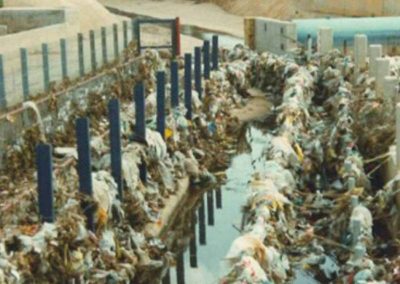Robinson Canal Littertrap – Johannesburg, South Africa
Project overview
Statistics:
- Purpose: to intercept polluted low flow and remove litter
- Type: FDS canal regulating gate and diaphragm valve (DV)
- Size: 9 m long by 2,2m high
- Operating system: gate to remain closed upto 1:15 yr flood and then to open. DV to open for low flows and to close during rainstorms
- Screens: Special vertical screens, easy to clean
- Material: Mild steel copon protected and galvanized screens
Location: Robinson Canal, City Deep, Johannesburg
Client: Johannesburg City Council
Consultant: Flowgate Projects (Pty) Ltd
Scope of services: Design, Fabrication, Installation, Commissioning
Completion: 1990
Background
The Robinson Canal drains stormwater from 8 km2 of central Johannesburg CBD. With each rainstorm a substantial amount of litter and debris is carried down the canal which was previously deposited as unsightly piles of litter on the banks of the Klipspruit stream.
In addition to litter, the Robinson canal also carried raw sewerage from overflowing sewers from the city which continued into the Klipspruit and through the township of Soweto, giving rise to health problems.
In order to meet DWA legislation, the Johannesburg City council required that the sewerage be intercepted and diverted into the Klipspruit main sewer outfall and that litter and debris be intercepted and removed.
Description
An automatic self regulating canal gate was installed in the canal to divert stormwater through a series of specially designed screens before re entering the canal, essentially litter free. The regulating gate is designed to remain closed for all flows up to the 1:15 year storm event and then to open for larger flows in order not to cause the canal to overflow upstream.
The low flows are intercepted by a drop catchpit and led into a settling chamber where oil is removed. The low flows are then controlled by an automatic diaphragm valve before discharging vertically into the main Klipspruit outfall sewer, some 20 m below.
The diaphragm valve is design to close down when the water level in the canal rises due to a rainstorm so as not to surcharge the sewer outfall with rainwater, and to open again when the water level in the canal recedes to pass the polluted low flows into the outfall sewer.
The litter trap proved to be very effective. On average 70 to 100 bags of litter was removed after every rain event. A considerable amount of oil was also removed with the litter. The raw sewerage has also been effectively interrupted in the low flows.

